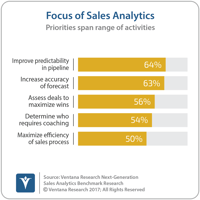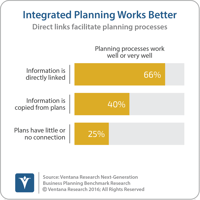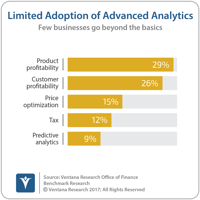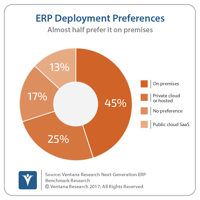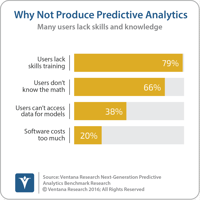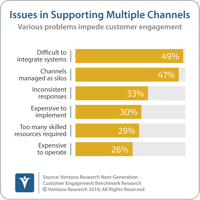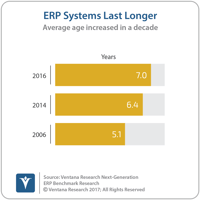Ever since I became involved in the CRM and customer service markets, everyone – businesses, vendors, consultants and analysts – has been talking and writing about the “360-degree view of the customer”. Despite claims from several vendors, I haven’t seen any products that produce a full 360-degree view, and user organizations haven’t had the time or resources to develop the technology themselves. As our research into next-generation customer analytics shows, the main issue is data –...
Read More
Topics:
Customer Analytics,
Customer Engagement,
Customer Experience,
Office of Finance,
Customer Service,
Contact Center
I have been following advances in sales analytics since the 1990s. Over the last five years, however, I have seen evolution, not innovation. In most cases the information that analytics provides is too complicated and not contextualized enough for sales people who are not analytics experts to understand, let alone take action on. As I pointed out in my 2017 research agenda on sales, analytics is essential for planning that improves the impacts of sales efforts and meets the goals of the...
Read More
Topics:
Big Data,
Sales,
Mobile Technology,
Office of Finance,
Analytics,
Cloud Computing,
Collaboration,
Product Information Management,
Sales Performance Management,
Digital Commerce,
Sales and Operations Planning,
Machine Learning and Cognitive Computing,
Sales Enablement and Execution,
Machine Learning Digital Technology,
Sales Planning and Analytics
Anaplan recently held Anaplan Hub, its annual user group meeting. The company offers a cloud-based business planning platform that incorporates a modeling and calculation engine. The tool makes it relatively easy to add or expand the scope of plans that can be connected and monitored as a central source. Companies typically use Anaplan software for financial planning or budgeting, sales, workforce, marketing and IT planning. These are the types of plans in which companies often need to create...
Read More
Topics:
Customer Analytics,
Human Capital Management,
Marketing,
Marketing Performance Management,
Office of Finance,
Recurring Revenue,
Continuous Planning,
Analytics,
Business Intelligence,
Cloud Computing,
Collaboration,
HRMS,
Sales Performance Management,
Workforce Management,
Financial Performance Management,
Price and Revenue Management,
Work and Resource Management,
Operations & Supply Chain,
Sales Enablement and Execution,
ERP and Continuous Accounting,
Sales Planning and Analytics
Pricing is an issue that affects almost every for-profit company that doesn’t sell purely commodity products. A corporation’s approach to pricing can range from highly disciplined to ad hoc and from fully centralized to decentralized. The issue of centralized or decentralized depends a great deal on the markets the company serves, its organizational structure and its culture. However, a disciplined approach to price setting and negotiation is always superior to an ad hoc approach. This is...
Read More
Topics:
Big Data,
Office of Finance,
Continuous Planning,
Analytics,
Sales Performance Management,
Financial Performance Management,
Price and Revenue Management,
Pricing and Promotion Management,
Sales Enablement and Execution,
ERP and Continuous Accounting,
Sales Planning and Analytics
Oracle recently held its second ERP Cloud Summit with industry analysts. The all-day event wasn’t just about ERP. The company covered a range of its business applications, including financial performance management as well as its Adaptive Intelligent Applications. And it wasn’t just about the cloud. After more than a decade of steady developments, ERP systems have begun to change fundamentally, facilitated by the growing availability of new technologies including cloud computing, advanced...
Read More
Topics:
Big Data,
Data Science,
Mobile,
Customer Experience,
Human Capital Management,
Machine Learning,
Office of Finance,
Analytics,
Data Integration,
Internet of Things,
Cognitive Computing,
HRMS,
Financial Performance Management,
Mobile Marketing Digital Commerce,
Digital Marketing,
Digital Commerce,
Operations & Supply Chain,
Enterprise Resource Planning,
ERP and Continuous Accounting
Some 3,000 people attended Domo’s recent customer event, called Domopalooza. That’s nearly double the attendance of the previous event, which my colleague Mark Smith covered. Formerly a bit “stealthy,” Domo has started sharing more information, some of which I’ll pass along, as well as observations about product announcements made at the event.
Read More
Topics:
Data Science,
Mobile,
Mobile Technology,
Analytics,
Business Intelligence,
Cloud Computing,
Collaboration,
Machine Learning and Cognitive Computing,
Machine Learning Digital Technology
In tracking Genesys for several years I have seen it grow through a series of product developments and acquisitions – from predominantly selling call routing and computer/telephony integration (CTI) software to providing a suite of products that manage inbound and outbound, assisted and digital channels of customer engagement. Continuing this expansion Genesys recently acquired Interactive Intelligence and Silver Lining. These new assets signal another round of transformation as the company...
Read More
Topics:
Mobile,
Customer Analytics,
Customer Engagement,
Customer Experience,
Office of Finance,
Analytics,
Cloud Computing,
Collaboration,
Customer Service,
Internet of Things,
Contact Center,
Digital Technology
Ventana Research recently announced the results of its latest Benchmark Research, Next-Generation ERP. The enterprise resource planning (ERP) system is at the core of nearly every company’s record-keeping and management of business processes. Its smooth and uninterrupted functioning is essential to an organization’s accounting and finance functions. In manufacturing and distribution, ERP manages inventory and logistics. Some companies use it to handle human resources functions like tracking...
Read More
Topics:
Big Data,
Mobile,
Human Capital Management,
Office of Finance,
Cloud Computing,
Collaboration,
Inventory Optimization,
Work and Resource Management,
Enterprise Resource Planning,
ERP and Continuous Accounting
I recently attended SAS Institute’s analyst relations conference. There the company provided updates on its financial performance and its Viya platform and a glimpse into some of its future plans.
Read More
Topics:
Big Data,
Data Science,
Mobile Technology,
business intelligence,
Analytics,
Cloud Computing,
Collaboration,
Data Governance,
Data Integration,
Data Preparation,
Internet of Things,
Information Optimization,
Machine Learning and Cognitive Computing,
Machine Learning Digital Technology


